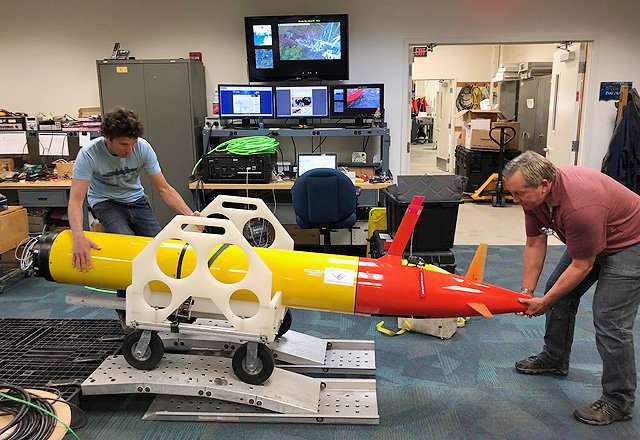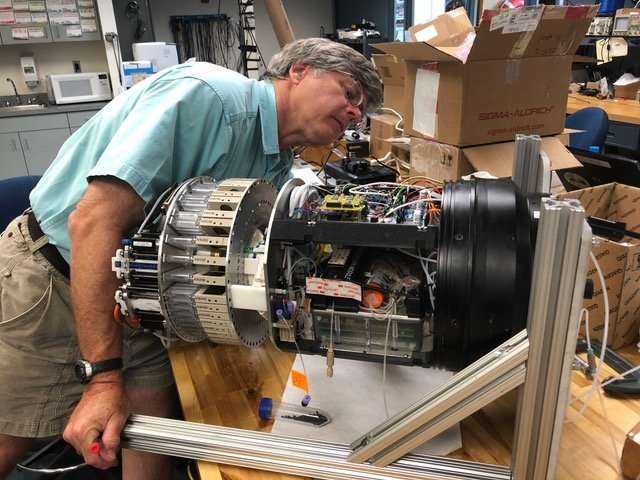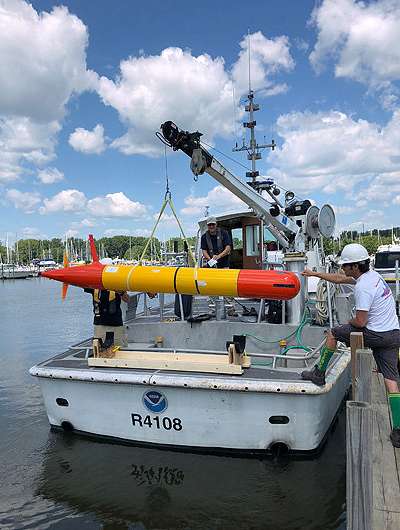MBARI engineer Brian Kieft and SURF Center Director Jim Birch work on a long-range AUV at NOAA’s Great Lakes Laboratory. Credit: NOAA
Microcystin is a nasty toxin that can cause skin reactions, stomach problems, and even liver damage. It's produced by a tiny blue-green alga (cyanobacteria) called Microcystis, which multiplies like crazy in warm, nutrient-rich water. Unfortunately, Microcystis blooms are becoming increasingly common in the Great Lakes, which provide drinking water for millions of people. This month researchers from MBARI and the National Oceanographic and Atmospheric Administration (NOAA) are testing a new underwater robot that will swim around Lake Erie measuring the amount of microcystin and algae in the water, and send its findings back to shore in real time.
The robot is one of MBARI's long-range autonomous underwater vehicles (LRAUVs). At about 30 centimeters (one foot) in diameter and 230 centimeters (7.5 feet) long, it looks like a small, yellow and orange torpedo. But it is much slower than a torpedo and is designed specifically to spend weeks in the water collecting scientific data.
For the last eight years, MBARI's scientists and engineers have been building LRAUVs and using them to study microscopic algae and ocean chemistry off the California coast. In 2018, they built a new LRAUV that carries a robotic biochemistry lab. This automated laboratory is called a third-generation Environmental Sample Processor (3G ESP). While the LRAUV moves through the water the 3G ESP collects samples of water, filters them, and then processes the samples to detect microscopic organisms or toxins such as microcystin. After analyzing the samples, the 3G ESP can send its findings to scientists on shore via satellite link.
MBARI engineers have been working on the 3G ESP for about five years. This spring marked its first big test, with LRAUVs carrying 3G ESPs in the open ocean off Hawaii to collect samples of the microscopic algae that support open-ocean food webs. In late July 2018 a similar LRAUV collected harmful algae and monitored algal toxins in the cold waters of Monterey Bay. Now this same vehicle is being used to monitor microcystin in the waters of Lake Erie.
MBARI Senior Research Specialist Bill Ussler prepares a third-generation Environmental Sample Processor for use in Lake Erie. Credit: NOAA.
Because so many cities get their drinking water from the Great Lakes, NOAA already issues forecasts that predict where and when harmful algal blooms are likely to produce microcystin. Researchers hope that data from LRAUVs will eventually help with these forecasts. As Steve Ruberg, a scientist with NOAA's Great Lakes Environmental Research Laboratory, pointed out, "Getting information about how deep toxins from a harmful algal bloom go and how close they are to municipal water intake pipes can help NOAA improve forecasts and decision-support tools that Great Lakes communities depend on."
MBARI engineers deployed a second-generation version of the ESP in Lake Erie in 2017. Over the past year, this instrument has been measuring microcystin concentrations from a mooring about 6.5 kilometers (four miles) west of the main drinking-water intake for the city of Toledo, Ohio.
The 2018 project involves several "firsts." It is the first time that MBARI's autonomous vehicles will be finding their way around a relatively shallow body of water such as Lake Erie, which averages about 19 meters (62 feet) deep. It is also the first time that MBARI's 3G ESP has been outfitted with automated instruments to detect microcystin.
Researchers hoist a long-range AUV onto a NOAA research vessel that will carry it out into the open waters of Lake Erie. Credit: NOAA
After launching the LRAUV from a small boat, researchers will return to shore to monitor its progress. The robot will stay underwater most of the time, but surface periodically to let scientists know where it is and what it is "seeing." It will also collect and preserve water samples for later analysis on shore.
Microbiologists will extract DNA from these preserved samples to find out about not just Microcystis, but the entire community of microbes in the lake. This will help them understand the conditions that contribute to dangerous algal blooms.
"This approach is unique in the sense that we're merging elements of robotics, biochemistry, and free-ranging autonomous systems," said Chris Scholin, president of MBARI and inventor of the Environmental Sample Processor. "Our goal is to detect and track toxins as they change over space and time. This way we won't be reliant on fixed sensors and on sending people to collect samples and then process them. By advancing the state of art in mobile toxin-detection capability, we hope to eventually provide new options for resource managers and public health agencies."
Provided by Monterey Bay Aquarium Research Institute

























